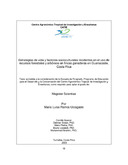| dc.contributor.author | Ramos Urzagaste, M.L. | |
| dc.date.accessioned | 2014-10-18T01:58:15Z | |
| dc.date.available | 2014-10-18T01:58:15Z | |
| dc.date.issued | 2003 | es_ES |
| dc.identifier | 365864 | es_ES |
| dc.identifier.uri | https://repositorio.catie.ac.cr/handle/11554/2886 | |
| dc.description | Tesis (M. Sc) -- CATIE, Turrialba (Costa Rica),2003 | es_ES |
| dc.description | 18 ilustraciones. 22 tablas. 1 mapa | |
| dc.description.abstract | En las pasadas décadas, grandes áreas de bosque seco tropical costarricense fueron removidas para dar paso a la Ganadería (cerca del 40 por ciento del territorio fue deforestado), la cual constituye un porcentaje importante de uso de la tierra en la zona de Guanacaste (más del 70 por ciento de este territorio). Muchas de esas tierras son de baja fertilidad y por ende, de vocación forestal. En muchos casos se han observado rendimientos productivos decrecientes. La drástica reducción de la cobertura arbórea del bosque seco tropical, el deterioro del suelo y la pérdida de biodiversidad, han conducido a la disminución de los servicios ambientales que proveía el bosque en la zona. Se seleccionaron al azar 53 hogares con fincas ubicadas en la zona del bosque seco tropical que practican Ganadería en los Cantones de Cañas y Bagaces, provincia Guanacaste, Costa Rica. Se realizaron entrevistas semi-estructuradas a los dueños de finca para entender sus estrategias de vida y conocer los factores subjetivos que inciden en su decisión a favor o en contra de tener recursos forestales y arbóreas (RFA) en sus fincas. Finalmente, se elaboró una tipología de hogares con base en los diferentes aspectos del estudio. Se distinguieron cuatro tipos de hogares ganaderos, según la importancia relativa de sus actividades desempeñadas dentro y fuera de la finca y diferenciando los respectivos grupos mejor y peor dotados. | es_ES |
| dc.description.abstract | In the last few decades, large areas of tropical dry forest in Costa Rica have been removed for livestock production (approximately 40 percent of the national territory has been deforested), which constitutes more than 70 percent of land use in the Guanacaste region. The poor soils of this area, which would be better suited to forestry activities, have been gradually declining in productivity. The considerable reduction of forest cover, coupled with soil degradation and loss of biodiversity, have also lead to a decline in the environmental services provided by the forest ecosysteMON of the region. Semi-structured interviews were conducted with 53 randomly selected farm households in Cañas and Bagaces cantons (Guanacaste province) to gain an understanding of their livelihood strategies as well as the factors influencing their decisions for maintaining forest and tree resources on their farMON. On the basis of both quantitative and qualitative aspects of the study, a household typology was developed. Four broad types of farming households were distinguished, based on the relative importance of on- and off-farm activities, as well as, relative economic status. | |
| dc.format.extent | 134 páginas | |
| dc.language.iso | es | es_ES |
| dc.publisher | CATIE, Turrialba (Costa Rica) | es_ES |
| dc.subject | COSTA RICA | |
| dc.subject | GANADERIA | |
| dc.subject | EXPLOTACIONES AGRARIAS | |
| dc.subject | UTILIZACION DE LA TIERRA | |
| dc.subject | ENTORNO SOCIOCULTURAL | |
| dc.subject | RECURSOS FORESTALES | |
| dc.subject | RIESGO | |
| dc.subject | DESARROLLO RURAL | |
| dc.subject | DESARROLLO ECONOMICO Y SOCIAL | |
| dc.subject | ENTORNO SOCIOCULTURAL | |
| dc.subject | PARTICIPACION SOCIAL | |
| dc.title | Estrategias de vida y factores socioculturales incidentes en el uso de recursos forestales y arbóreos en fincas ganaderas en Guanacaste, Costa Rica | es_ES |
| dc.title.alternative | Livelihood strategies and socio-cultural factors influencing forest resource use on cattle farMON in Guanacaste, Costa Rica | es_ES |
| dc.type | Tesis de maestría | es_ES |
| dc.identifier.publication | Turrialba (Costa Rica) | es_ES |


